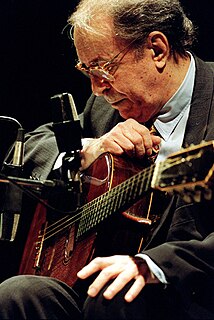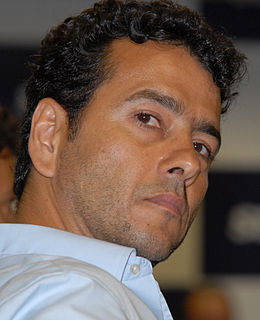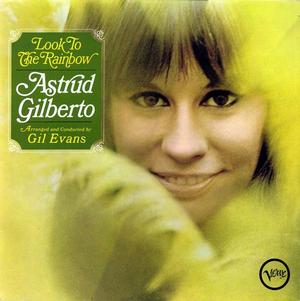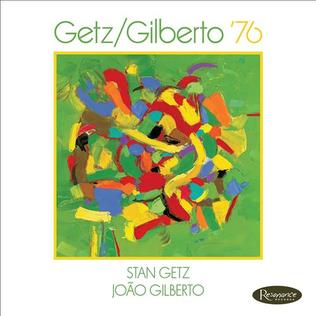This article relies largely or entirely on a single source .(April 2016) |
| João | |
|---|---|
 | |
| Studio album by | |
| Released | July 23, 1991 |
| Genre | Bossa Nova |
| Label | Polygram do Brazil Ltda. |
| Producer | Mayrton Bahia |
João is a 1991 album by João Gilberto.
This article relies largely or entirely on a single source .(April 2016) |
| João | |
|---|---|
 | |
| Studio album by | |
| Released | July 23, 1991 |
| Genre | Bossa Nova |
| Label | Polygram do Brazil Ltda. |
| Producer | Mayrton Bahia |
João is a 1991 album by João Gilberto.
Allmusic awarded the album 4 stars.
| Review scores | |
|---|---|
| Source | Rating |
| Allmusic | |
| The Philadelphia Inquirer | 4/4 [2] |
The 7th Annual Grammy Awards were held on April 13, 1965, at Beverly Hilton Hotel, Beverly Hills. They recognized accomplishments of musicians for the year 1964. João Gilberto & Stan Getz won 4 awards.

Stanley Getz was an American jazz saxophonist, known professionally as Stan Getz. Playing primarily the tenor saxophone, Getz was known as "The Sound" because of his warm, lyrical tone, with his prime influence being the wispy, mellow timbre of his idol, Lester Young. Coming to prominence in the late 1940s with Woody Herman's big band, Getz is described by critic Scott Yanow as "one of the all-time great tenor saxophonists". Getz performed in bebop and cool jazz groups. Influenced by João Gilberto and Antônio Carlos Jobim, he popularized bossa nova in the United States with the hit single "The Girl from Ipanema" (1964).

João Gilberto was a Brazilian singer, songwriter, and guitarist, who was a pioneer of the musical genre of bossa nova in the late 1950s. Around the world he was often called "father of bossa nova"; in his native Brazil, he was referred to as "O Mito".

Getz/Gilberto is an album by American saxophonist Stan Getz and Brazilian guitarist João Gilberto, featuring pianist and composer Antônio Carlos Jobim, who also composed many of the tracks. It was released in March 1964 by Verve Records. The album features the vocals of Astrud Gilberto on two tracks, "Garota de Ipanema" and "Corcovado". The artwork was done by artist Olga Albizu. Getz/Gilberto is a jazz and bossa nova album and includes tracks such as "Desafinado", "Corcovado", and "Garota de Ipanema". The last received a Grammy Award for Record of the Year and started Astrud Gilberto's career. "Doralice" and "Para Machucar Meu Coração" strengthened Gilberto's and Jobim's respect for the tradition of pre-bossa nova samba.

Isabel Gilberto de Oliveira, known as Bebel Gilberto, is an American-born Brazilian popular singer often associated with bossa nova. She is the daughter of João Gilberto and singer Miúcha. Her uncle is singer/composer Chico Buarque.

Maria Bethânia Viana Teles Veloso is a Brazilian singer and songwriter. Born in Santo Amaro, Bahia, she started her career in Rio de Janeiro in 1964 with the show "Opinião" ("Opinion"). Due to its popularity, with performances all over the country, and the popularity of her 1965 single "Carcará", the artist became a star in Brazil.

João Voz e Violão is a bossa nova album by João Gilberto, released in 2000. Recording very little in the 1990s, this album is Gilberto's first studio album since 1991's João. The album won the 2001 Grammy Award for Best World Music Album.

In Tokyo is a bossa nova album by João Gilberto, recorded live in Tokyo (Japan) in September 2003 and released in 2004.

Chega de Saudade is the debut album by Brazilian musician João Gilberto and is often credited as the first bossa nova album. The title can be translated roughly as "enough longing", though the Portuguese word saudade carries with it more complex meaning.

Getz/Gilberto #2 is a live album by Stan Getz and João Gilberto, released in 1966. It was recorded at a live concert at Carnegie Hall in October 1964. The previous album Getz/Gilberto won the 1965 Grammy Awards for Best Album of the Year and Best Jazz Instrumental Album - Individual or Group amongst others. The painting on the cover is by Olga Albizu.

João Donato de Oliveira Neto is a Brazilian jazz and bossa nova pianist from Brazil. He first worked with Altamiro Carrilho and went on to perform with Antonio Carlos Jobim and Astrud Gilberto.

Stan Getz meets João & Astrud Gilberto: New York 1964 is a live recording of bossa nova in the making. In 1990, the Giants of Jazz label released a live recording of a 1964 New York City performance featuring Stan Getz, João Gilberto and Astrud Gilberto, his then-wife. The album, entitled Stan Getz meets João & Astrud Gilberto is actually misleading: the trio had met previously in 1963 for the recording of the wildly successful album Getz/Gilberto, which was released in 1964 and set off the bossa nova frenzy in the U.S. As a result of that album’s success, the Brazilian Gilbertos and the American Getz played a number of shows in the U.S., such as the one recorded here. Released as part of the “Immortal Concerts” series, this recording exhibits the chemistry the three obviously shared and captures bossa nova in its infancy, as it was still being created and defined.

Marcos Palmeira de Paula is a Brazilian actor, TV host and producer. He is nephew of the siblings Chico Anysio and Lupe Gigliotti. In 2013, he was nominated for an International Emmy Award for best actor for his role in the series Mandrake.

Astrud Gilberto is a Brazilian samba and bossa nova singer. She gained international attention in the 1960s following her recording of the song "The Girl from Ipanema".
"Eu Sei Que Vou Te Amar" is a bossa nova jazz standard composed by Antônio Carlos Jobim and Vinícius de Moraes. The first recording was by the Brazilian singer Maysa, appeared on her 33 rpm LP, RGE - XRLP 5068, published in 1959. Another version was the 13th track on Vinícius de Moraes's 1970 album En 'la Fusa' con Maria Creuza y Toquinho.
Andrew "Andrucha" Waddington is a Brazilian film director, producer, and screenwriter.

Look to the Rainbow is a 1966 album by Astrud Gilberto, arranged by Gil Evans and Al Cohn.

Brasil is a 1981 album by Brazilian artist João Gilberto, featuring Caetano Veloso, Gilberto Gil and Maria Bethânia. The album was later released along with João Gilberto's 1977 album Amoroso.

Getz/Gilberto '76 is a live album by saxophonist Stan Getz and guitarist/vocalist João Gilberto which was recorded at Keystone Korner in 1976 and released on the Resonance label in 2016.
"Fotografia" is a bossa nova song written and composed in 1959 by Antônio Carlos Jobim. English lyrics were published in 1965 by Ray Gilbert.